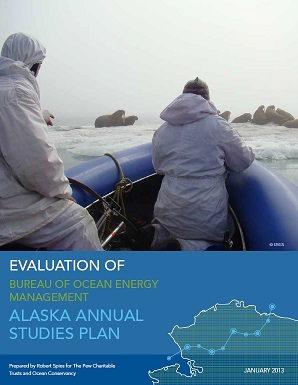Science Short: Evaluation of Alaska Annual Studies Plan
Alaska Annual Studies Plan
The Bureau of Ocean Energy Management's (BOEM) fiscal year 2012 Alaska Annual Studies plan is evaluated and a number of overarching issues are discussed, including monitoring, integration of science, documenting cumulative effects and building development scenarios. In addition, selected specific topics are evaluated, including walrus, bowhead whales and noise, subsistence, Arctic cod and small fishes, and birds. The major findings and recommendation are summarized as follows:
- Monitoring the marine environment. There is still no comprehensive, long-term, integrated monitoring program for the Beaufort and Chukchi seas. BOEM needs to support efforts, such as the Distributed Biological Observatory, in order to track changes in the Arctic Ocean as industrialization and climate change impact these ecosystems. There is no plan yet in place to track ecological changes over decades, the scale at which significant changes are most likely to become apparent. The funding cycles for research, usually up to five years for individual projects, are at odds with the decadal scales on which marine ecosystems change.
- Integration of science. There are many organizations and agencies sponsoring scientific research in the Arctic Ocean. BOEM and other sponsors would greatly benefit from more integration of these research and monitoring efforts. Some efforts at integration are under way, such as participation in joint planning, which might lead eventually to integration in other areas, such as logistics, obtaining geographic completeness, data sharing and synthesis. The BOEM study plans for the Arctic should be presented and rationalized with respect to other major efforts in the Arctic marine environment.
- Documenting cumulative effects. Despite more than 30 years of oil and gas activity, as well as military activity, in the Arctic, there is no clear picture—or even attempted analysis—of the cumulative effects of these activities in the U.S. Arctic Ocean and coastal zone. The instigation of a comprehensive long-term monitoring program informed by development scenarios, as indicated below, would help make this possible.
- Building potential development scenarios. To design appropriate monitoring strategies and document cumulative effects, BOEM shouldcreate likely scenarios for developing infrastructure, extractive processes, and associated transport and staging of equipment and personnel and other operations.
- Using science in decision-making. If decision-making processes on offshore oil and gas development are to be designed to minimize harm, then it must be clear how the results of scientific studies are being incorporated into such decisions. For example, science should more clearly inform decisions about where drilling should and should not take place.
- Effects of noise on bowhead whales. Further efforts should be directed toward establishing inventories and databases of anthropogenic noise and to integrate data on noise sources and whale movements.
- Arctic cod and other forage species. While BOEM is initiating much new work on Arctic cod and similar forage species, and this is to BOEM's credit, we do not yet understand the basic life histories of these species (e.g., their reproductive biology and critical habitat for various life history stages).
- Arctic seabirds. Planned BOEM studies do a reasonably good job of addressing research needs for Arctic seabirds. However, it would be beneficial if some of the existing seabird colony data from the coast of the Chukchi Sea were published in the peer-reviewed scientific literature.
- Subsistence. A synthesis is needed of what has been learned from more than 30 years of subsistence studies in the U.S. Arctic. There also needs to be a more systematic approach to incorporating traditional knowledge into BOEM-sponsored projects.
- Use of traditional knowledge. An evaluation of how traditional knowledge has been used in the decision-making process is needed to see where improvements might be made and decisions potentially improved.











